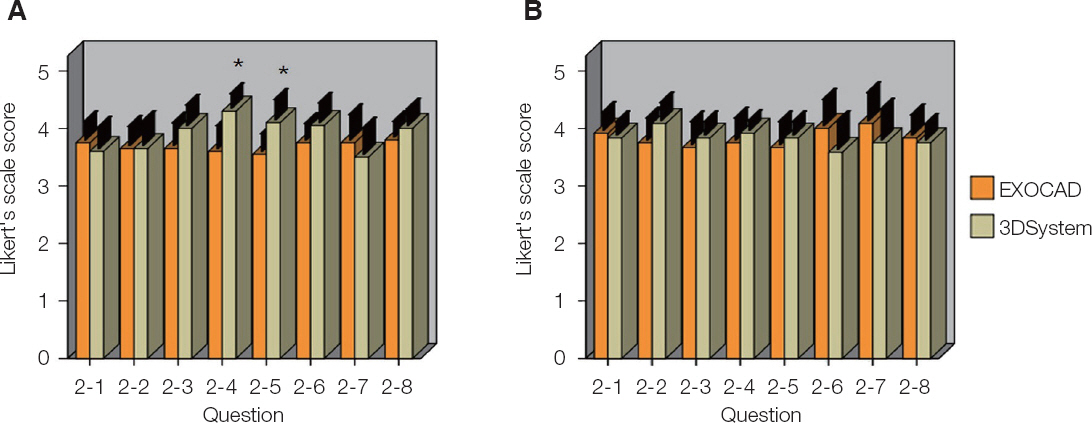J Dent Rehabil Appl Sci.
2019 Mar;35(1):11-19. 10.14368/jdras.2019.35.1.11.
Evaluating usability of and satisfaction with two types of dental CAD software
- Affiliations
-
- 1Department of Prosthodontics, School of Dentistry, Kyungpook National University, Daegu, Republic of Korea. kblee@knu.ac.kr
- 2Advanced Dental Device Development Institute, Kyungpook National University, Daegu, Republic of Korea.
- 3Department of Dental Science, Graduate School, Kyungpook National University, Daegu, Republic of Korea.
- KMID: 2450921
- DOI: http://doi.org/10.14368/jdras.2019.35.1.11
Abstract
- PURPOSE
This study evaluated the usability of and satisfaction with two types of computer-aided design (CAD) software among users who had experience with dental implant CAD software and those who did not.
MATERIALS AND METHODS
Dental technicians (n = 20) who had previous experience with dental implant CAD Software and students from the College of Dentistry (n = 12) who had never designed implant custom abutments were asked to evaluate two types of CAD Software, Exocad and Deltanine. In addition, the participants were asked to fill out a structured questionnaire (Section 1: Entering basic information and retrieving files; Section 2: Setting conditions before abutment design; Section 3: Setting abutment design; and Section 4: Overall satisfaction). For the statistical analysis of the collected data, Mann-Whitney U test was used (α = .05).
RESULTS
The ease of design and satisfaction with the implant CAD Software, evaluated with respect to 21 statements divided into four Stages, were significantly higher for Exocad in both groups for Secion 1. For Sections 2 and 3, participants with experience evaluated Deltanine to be significantly better. For Section 4, both groups evaluated Exocad Software to be better.
CONCLUSION
Overall, the Exocad Software was evaluated as having better usability and offering greater satisfaction. However, in terms of performance in the core of the design process, i.e. Sections 2 and 3, Deltanine was rated higher by the experienced users. Thus, if the user interface design parts are supplemented, Deltanine CAD Software could be put to a wider use in clinics.
Keyword
Figure
Reference
-
References
1. Tapie L, Chiche N, Boitelle P, Morenton P, Attal JP, Schmitt N, Vennat E. Adaptation measurement of CAD/CAM dental crowns with X-ray micro-CT:metrological chain standardization and 3D gap size distribution. Advances Mater Sci Eng. 2016; 4:13. DOI: 10.1155/2016/7963928.2. Fasbinder DJ. Computerized technology for restorative dentistry. Am J Dent. 2013; 26:115–20.3. van Noort R. The future of dental devices is digital. Dent Mater. 2012; 28:3–12. DOI: 10.1016/j.dental.2011.10.014. PMID: 22119539.4. Miyazaki T, Hotta Y, Kunii J, Kuriyama S, Tamaki Y. A review of dental CAD/CAM:current status and future perspectives from 20 years of experience. Dent Mater J. 2009; 28:44–56. DOI: 10.4012/dmj.28.44. PMID: 19280967.5. Beuer F, Schweiger J, Edelhoff D. Digital dentistry:an overview of recent developments for CAD/CAM generated restorations. Br Dent J. 2008; 204:505–11. DOI: 10.1038/sj.bdj.2008.350. PMID: 18469768.6. Park JH, Kim JE, Shim JS. Digital workflow for a dental prosthesis that considers lateral mandibular relation. J Prosthet Dent. 2017; 117:340–44. DOI: 10.1016/j.prosdent.2016.07.034. PMID: 28341253.7. Davidowitz G, Kotick PG. The use of CAD/CAM in dentistry. Dent Clin North Am. 2011; 55:559–70. DOI: 10.1016/j.cden.2011.02.011. PMID: 21726690.8. Koch GK, Gallucci GO, Lee SJ. Accuracy in the digital workflow:from data acquisition to the digitally milled cast. J Prosthet Dent. 2016; 115:749–54. DOI: 10.1016/j.prosdent.2015.12.004. PMID: 26803173.9. Christensen GJ. Impressions are changing:deciding on conventional, digital or digital plus in-office milling. J Am Dent Assoc. 2009; 140:1301–4. DOI: 10.14219/jada.archive.2009.0054. PMID: 19797561.10. Lins L, Bemfica V, Queiroz C, Canabarro A. In vitro evaluation of the internal and marginal misfit of CAD/CAM zirconia copings. J Prosthet Dent. 2015; 113:205–11. DOI: 10.1016/j.prosdent.2014.09.010. PMID: 25453562.11. Son KBD, Lee WS, Lee KB. Effect of repeated learning for two dental CAD Software programs. J Dent Rehabil Appl Sci. 2017; 33:88–96. DOI: 10.14368/jdras.2017.33.2.88.12. Lijphart A II. The comparable-cases strategy in comparative research. Comp Polit Stud. 1975; 8:158–77. DOI: 10.1177/001041407500800203.13. Hyun SE, Park SY. Brand processing difference for experience and no-experience:cultural implications. J Culture Industry. 2014; 14:159–68.
- Full Text Links
- Actions
-
Cited
- CITED
-
- Close
- Share
- Similar articles
-
- Effect of repeated learning for two dental CAD software programs
- Use of the surface-based registration function of computer-aided design/computer-aided manufacturing software in medical simulation software for three-dimensional simulation of orthognathic surgery
- Comparative study of two CAD software programs on consistency between custom abutment design and the output
- Application of Systematic Digital Diagnosis to Create Dental Virtual Patients with Dynamic Occlusion for Esthetic Restoration of Anterior Teeth: A Case Report
- Effect of machining precision of single ceramic restorations on the marginal and internal fit






